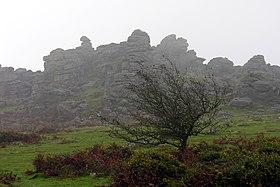Hound Tor
| Hound Tor | |
|---|---|

View of Hound Tor
|
|
| Highest point | |
| Elevation | 414 m (1,358 ft) |
| Prominence | c. 26 m |
| Coordinates | 50°35′46″N 3°46′44″W / 50.59623°N 3.77878°WCoordinates: 50°35′46″N 3°46′44″W / 50.59623°N 3.77878°W |
| Geography | |
| Location | Dartmoor, England |
| OS grid | SX742789 |
| Topo map | OS Landranger 191 |
Hound Tor is a tor on Dartmoor, Devon, England and is a good example of a heavily weathered granite outcrop. It is easily accessible, situated within a few minutes from the B3387 between Bovey Tracey and Widecombe-in-the-Moor.
The site is administered by Dartmoor National Park Authority for English Heritage as it includes the ruins of a medieval village, alongside prehistoric works of stone construction nearby.
Sabine Baring-Gould said that it derived its name from the shape assumed by the blocks on the summit that have been weathered into forms resembling the heads of dogs peering over the natural battlements.
To the south-east of the tor, on a north-eastern-facing slope are the remains of Hundatora, a deserted medieval village. This was built on land farmed originally in the Bronze Age and which may have been used for grazing in the Roman period. The village was excavated between 1961 and 1975. It has four Dartmoor longhouses, many with a central drainage channel, and several smaller houses and barns. These buildings date from the 13th century. The three grain storage barns appear to have been adapted to include corn dryers, indicative of the deteriorating climate. Pollen evidence indicates that farming had stopped by 1350, but recent analysis of pottery suggests that the village was probably occupied until the late 14th or early 15th century.
The settlement is first mentioned in the Domesday Book as belonging to :
Land for 4 ploughs. In Lordship 1 plough; 2 slaves; 1 virgate, 2 villages and 4 smallholders with 1 plough and 1 virgate. Meadow, 9 acres; woodland 2 acres; pasture, 1 league. 1 cattle; 28 sheep; 18 goats. Value 20 s.
...
Wikipedia

